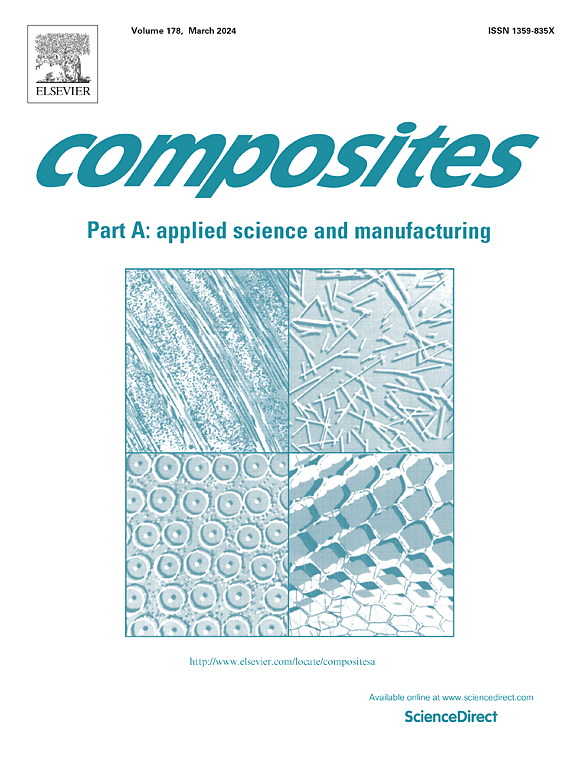IF 8.1
2区 材料科学
Q1 ENGINEERING, MANUFACTURING
Composites Part A: Applied Science and Manufacturing
Pub Date : 2025-04-17
DOI:10.1016/j.compositesa.2025.108959
引用次数: 0
摘要
本研究展示了一种基于双动态共价自适应网络(CAN)的玻璃聚合物施胶系统,它是一种有效的界面改性剂,可改善碳纤维增强环氧树脂(CFRE)复合材料的机械性能并引入自修复功能。这里使用的动态交联剂是 3,3-二硫代二丙酸,当它与基于 DGEBA 的环氧预聚物结合时,可在系统中安装双重动态 CAN。使用 DSC、TGA 和 DMA 技术分析了热转变、降解行为和粘弹性能。基体中加入的基于玻璃聚合物的施胶和氧化石墨烯(GO)协同改善了机械性能,ILSS 和 FS 值分别显著提高了 23% 和 18%。在 180 °C 下进行 30 分钟的自愈合处理后,ILSS 值显著恢复了 46%。此外,GO-CFRE 系统的电磁干扰屏蔽效果达到了 -46 dB。这项研究还探讨了改良 CFRE 系统的电热加热和除冰性能。本文章由计算机程序翻译,如有差异,请以英文原文为准。

Dual dynamic CAN and graphene oxide offer unique synergism in improving mechanical properties and introducing self-healing in carbon fiber composites
This study demonstrates the use of a dual dynamic covalent adaptive network (CAN) based vitrimer sizing system as an effective interfacial modification to achieve improved mechanical performance and introduce self-healing in carbon fiber-reinforced epoxy (CFRE) composites. The dynamic crosslinker used here is 3,3-Dithiodipropionic acid, which, when combined with DGEBA-based epoxy prepolymer, installs a dual dynamic CAN in the system. Thermal transitions, degradation behavior, and viscoelastic performance were analyzed using DSC, TGA, and DMA techniques. The vitrimer-based sizing and graphene oxide (GO) incorporated in the matrix synergistically improve the mechanical performance with a noteworthy increase of 23 % and 18 % in ILSS and FS values, respectively. Following a self-healing treatment at 180 °C for 30 min, there was a remarkable 46 % recovery in ILSS value. Additionally, the GO-CFRE system demonstrated an EMI shielding effectiveness of −46 dB. This study also explored the electrothermal heating and de-icing performance of the modified CFRE system.
求助全文
通过发布文献求助,成功后即可免费获取论文全文。
去求助
来源期刊

Composites Part A: Applied Science and Manufacturing
工程技术-材料科学:复合
CiteScore
15.20
自引率
5.70%
发文量
492
审稿时长
30 days
期刊介绍:
Composites Part A: Applied Science and Manufacturing is a comprehensive journal that publishes original research papers, review articles, case studies, short communications, and letters covering various aspects of composite materials science and technology. This includes fibrous and particulate reinforcements in polymeric, metallic, and ceramic matrices, as well as 'natural' composites like wood and biological materials. The journal addresses topics such as properties, design, and manufacture of reinforcing fibers and particles, novel architectures and concepts, multifunctional composites, advancements in fabrication and processing, manufacturing science, process modeling, experimental mechanics, microstructural characterization, interfaces, prediction and measurement of mechanical, physical, and chemical behavior, and performance in service. Additionally, articles on economic and commercial aspects, design, and case studies are welcomed. All submissions undergo rigorous peer review to ensure they contribute significantly and innovatively, maintaining high standards for content and presentation. The editorial team aims to expedite the review process for prompt publication.
 求助内容:
求助内容: 应助结果提醒方式:
应助结果提醒方式:


